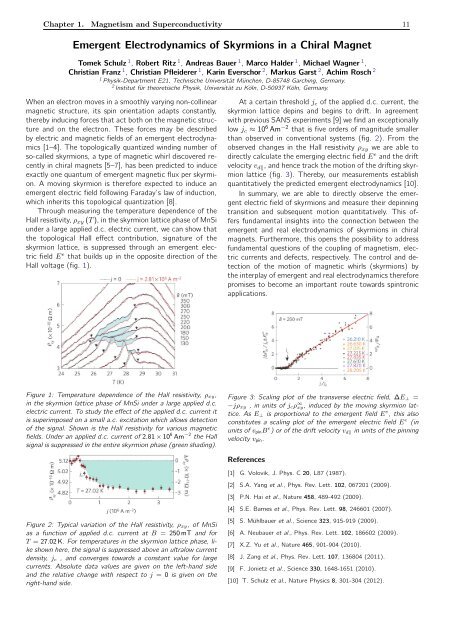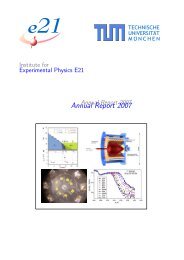Annual Report 2011 / 2012 - E21 - Technische Universität München
Annual Report 2011 / 2012 - E21 - Technische Universität München
Annual Report 2011 / 2012 - E21 - Technische Universität München
You also want an ePaper? Increase the reach of your titles
YUMPU automatically turns print PDFs into web optimized ePapers that Google loves.
Chapter 1. Magnetism and Superconductivity 11<br />
Emergent Electrodynamics of Skyrmions in a Chiral Magnet<br />
Tomek Schulz 1 , Robert Ritz 1 , Andreas Bauer 1 , Marco Halder 1 , Michael Wagner 1 ,<br />
Christian Franz 1 , Christian Pfleiderer 1 , Karin Everschor 2 , Markus Garst 2 , Achim Rosch 2<br />
1 Physik-Department <strong>E21</strong>, <strong>Technische</strong> Universität München, D-85748 Garching, Germany.<br />
2 Institut für theoretische Physik, Universität zu Köln, D-50937 Köln, Germany.<br />
When an electron moves in a smoothly varying non-collinear<br />
magnetic structure, its spin orientation adapts constantly,<br />
thereby inducing forces that act both on the magnetic structure<br />
and on the electron. These forces may be described<br />
by electric and magnetic fields of an emergent electrodynamics<br />
[1–4]. The topologically quantized winding number of<br />
so-called skyrmions, a type of magnetic whirl discovered recently<br />
in chiral magnets [5–7], has been predicted to induce<br />
exactly one quantum of emergent magnetic flux per skyrmion.<br />
A moving skyrmion is therefore expected to induce an<br />
emergent electric field following Faraday’s law of induction,<br />
which inherits this topological quantization [8].<br />
Through measuring the temperature dependence of the<br />
Hall resistivity,ρ xy (T), in the skyrmion lattice phase of MnSi<br />
under a large applied d.c. electric current, we can show that<br />
the topological Hall effect contribution, signature of the<br />
skyrmion lattice, is suppressed through an emergent electric<br />
field E e that builds up in the opposite direction of the<br />
Hall voltage (fig. 1).<br />
At a certain threshold j c of the applied d.c. current, the<br />
skyrmion lattice depins and begins to drift. In agreement<br />
with previous SANS experiments [9] we find an exceptionally<br />
low j c ≈ 10 6 Am −2 that is five orders of magnitude smaller<br />
than observed in conventional systems (fig. 2). From the<br />
observed changes in the Hall resistivity ρ xy we are able to<br />
directly calculate the emerging electric field E e and the drift<br />
velocity v d‖ , and hence track the motion of the drifting skyrmion<br />
lattice (fig. 3). Thereby, our measurements establish<br />
quantitatively the predicted emergent electrodynamics [10].<br />
In summary, we are able to directly observe the emergent<br />
electric field of skyrmions and measure their depinning<br />
transition and subsequent motion quantitatively. This offers<br />
fundamental insights into the connection between the<br />
emergent and real electrodynamics of skyrmions in chiral<br />
magnets. Furthermore, this opens the possibility to address<br />
fundamental questions of the coupling of magnetism, electric<br />
currents and defects, respectively. The control and detection<br />
of the motion of magnetic whirls (skyrmions) by<br />
the interplay of emergent and real electrodynamics therefore<br />
promises to become an important route towards spintronic<br />
applications.<br />
Figure 1: Temperature dependence of the Hall resistivity, ρ xy,<br />
in the skyrmion lattice phase of MnSi under a large applied d.c.<br />
electric current. To study the effect of the applied d.c. current it<br />
is superimposed on a small a.c. excitation which allows detection<br />
of the signal. Shown is the Hall resistivity for various magnetic<br />
fields. Under an applied d.c. current of 2.81×10 6 Am −2 the Hall<br />
signal is suppressed in the entire skyrmion phase (green shading).<br />
Figure 3: Scaling plot of the transverse electric field, ∆E ⊥ =<br />
−jρ xy , in units of j cρ ∞ xy, induced by the moving skyrmion lattice.<br />
As E ⊥ is proportional to the emergent field E e , this also<br />
constitutes a scaling plot of the emergent electric field E e (in<br />
units of v pin B e ) or of the drift velocity v d‖ in units of the pinning<br />
velocity v pin .<br />
References<br />
[1] G. Volovik, J. Phys. C 20, L87 (1987).<br />
[2] S.A. Yang et al., Phys. Rev. Lett. 102, 067201 (2009).<br />
[3] P.N. Hai et al., Nature 458, 489-492 (2009).<br />
[4] S.E. Barnes et al., Phys. Rev. Lett. 98, 246601 (2007).<br />
Figure 2: Typical variation of the Hall resistivity, ρ xy, of MnSi<br />
as a function of applied d.c. current at B = 250mT and for<br />
T = 27.02K. For temperatures in the skyrmion lattice phase, like<br />
shown here, the signal is suppressed above an ultralow current<br />
density, j c , and converges towards a constant value for large<br />
currents. Absolute data values are given on the left-hand side<br />
and the relative change with respect to j = 0 is given on the<br />
right-hand side.<br />
[5] S. Mühlbauer et al., Science 323, 915-919 (2009).<br />
[6] A. Neubauer et al., Phys. Rev. Lett. 102, 186602 (2009).<br />
[7] X.Z. Yu et al., Nature 465, 901-904 (2010).<br />
[8] J. Zang et al., Phys. Rev. Lett. 107, 136804 (<strong>2011</strong>).<br />
[9] F. Jonietz et al., Science 330, 1648-1651 (2010).<br />
[10] T. Schulz et al., Nature Physics 8, 301-304 (<strong>2012</strong>).




